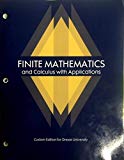
Set up and solve Exercises 35–40 by the simplex method.
37. Resource Management The average weights of the three species stocked in the lake referred to in Section 2.2, Exercise 59, are 1.62, 2.14, and 3.01 kg for species A, B, and C, respectively.
- (a) If the largest amounts of food that can be supplied each day are as given in Exercise 59, how should the lake be stocked to maximize the weight of the fish supported by the lake?
- (b) Does it require all of the available food to produce the maximum weight of fish? If not, how much of each type of food is left over?
- (c) Find a value for each of the average weights of the three species that would result in none of species B or C being stocked to maximize the weight of the fish supported by the lake, given the constraints in part (a).
- (d) Find a value for each of the average weights of the three species that would result in none of species A or B being stocked to maximize the weight of the fish supported by the lake, given the constraints in part (a).
59. Fish Food Requirements A lake is stocked each spring with three species of fish, A, B, and C. Three foods, I, II, and III, are available in the lake. Each fish of species A requires an average of 1.31 units of food I, 2.9 units of food II, and 1.75 units of food III each day. Species B fish each require 2.1 units of food I, 0.95 unit of food II, and 0.6 unit of food III daily. Species C fish require 0.86, 1.52, and 2.01 units of I, II, and III per day, respectively. If 490 units of food I, 897 units of food II, and 653 units of food III area available daily, how many of each species should be stocked?
Want to see the full answer?
Check out a sample textbook solution
Chapter 4 Solutions
Finite Mathematics and Calculus with Applications
- Explain the relationship between 12.3.6, (case A of 12.3.6) and 12.3.7arrow_forwardExplain the key points and reasons for the establishment of 12.3.2(integral Test)arrow_forwardUse 12.4.2 to determine whether the infinite series on the right side of equation 12.6.5, 12.6.6 and 12.6.7 converges for every real number x.arrow_forward
- use Corollary 12.6.2 and 12.6.3 to derive 12.6.4,12.6.5, 12.6.6 and 12.6.7arrow_forwardExplain the focus and reasons for establishment of 12.5.1(lim(n->infinite) and sigma of k=0 to n)arrow_forwardExplain the focus and reasons for establishment of 12.5.3 about alternating series. and explain the reason why (sigma k=1 to infinite)(-1)k+1/k = 1/1 - 1/2 + 1/3 - 1/4 + .... converges.arrow_forward
- Explain the key points and reasons for the establishment of 12.3.2(integral Test)arrow_forwardUse identity (1+x+x2+...+xn)*(1-x)=1-xn+1 to derive the result of 12.2.2. Please notice that identity doesn't work when x=1.arrow_forwardExplain the key points and reasons for the establishment of 11.3.2(integral Test)arrow_forward
 Linear Algebra: A Modern IntroductionAlgebraISBN:9781285463247Author:David PoolePublisher:Cengage LearningAlgebra & Trigonometry with Analytic GeometryAlgebraISBN:9781133382119Author:SwokowskiPublisher:Cengage
Linear Algebra: A Modern IntroductionAlgebraISBN:9781285463247Author:David PoolePublisher:Cengage LearningAlgebra & Trigonometry with Analytic GeometryAlgebraISBN:9781133382119Author:SwokowskiPublisher:Cengage

